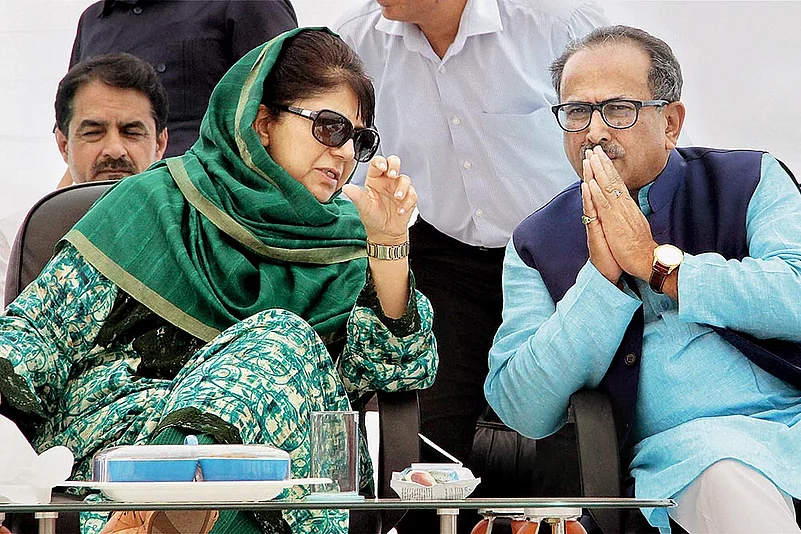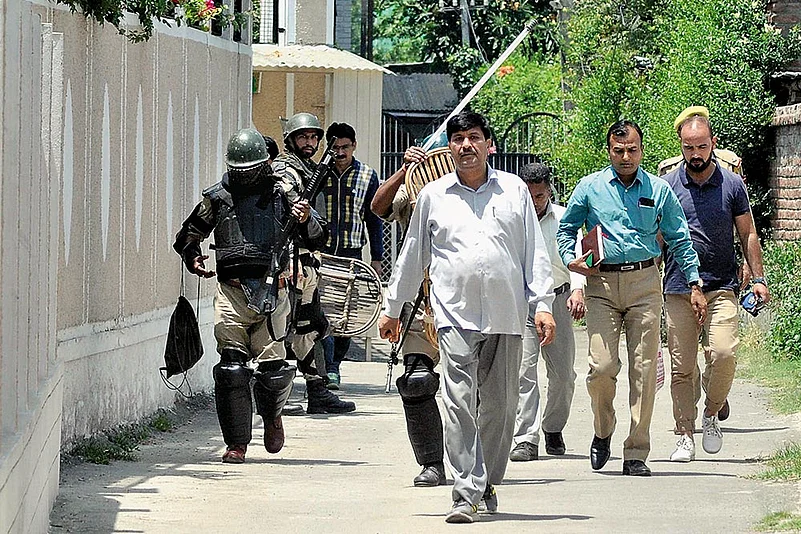In Union home minister Rajnath Singh’s talk of a “permanent solution for Kashmir”, the BJP’s ally in Jammu and Kashmir, the People’s Democratic Party (PDP), hears an intent to finally implement the “Agenda of Alliance” (AoA) the two parties had signed before forming the coalition government in the state. But, while the AoA—a “holy” document to the PDP, more important than the 1952 Delhi agreement between the then J&K prime minister Sheikh Abdullah and Indian PM Jawaharlal Nehru—envisages setting the stage for reconciliation through dialogue with all stakeholders, including the pro-independence Hurriyat Conference as well as Pakistan, Rajnath’s “permanent solution” pitch was soon followed by raids on Kashmiri traders and separatist leaders by the National Investigation Agency (NIA) on June 4 and 5.
A few days earlier, on May 31, PDP vice-president Sartaj Madani, who is also CM Mehbooba Mufti’s uncle, had said, “The PDP allied with the BJP out of a sincere desire to see J&K wriggle out of agonising instability. So Rajnath Singh’s statement that the government is making efforts to resolve the Kashmir issue at the earliest is significant. The PDP’s objective will be accomplished if this happens sooner rather than later.”
According to Madani, the PDP’s emergence as a political entity was necessitated by “the urgency to give the suffering people the much-needed relief” and the alliance with the BJP was based on a “clear agenda of peace and dialogue on Kashmir”. “Our party will follow this with fidelity and against all odds,” said the PDP vice-president.
While the PDP is keen to bring the AoA back on the agenda, the NIA raids have embarrassed it and surprised the separatists. The NIA, which carried out the raids following the questioning of separatist leaders Nayeem Ahmad Khan, Farooq Ahmed Dar alias ‘Bitta Karate’ and Gazi Javed Baba, did not have to face any protests or stone-pelting in the Valley. The three separatists had admitted to having received money from Pakistan in a sting operation by a New Delhi-based TV channel. The NIA believes the separatists are being funded by the bigger Pakistan-based tanzeems to “fuel militant activities and unrest in J&K”. Separatist leaders deny the charge and accuse the Centre of using the raids to defame and discredit them in the eyes of the people.

CM Mehbooba Mufti with deputy CM Nirmal Singh
The agency claims that its investigating teams found suspicious bank accounts and evidence of transactions, besides seizing correspondence with prisoners and mobile phones. During the raid on the residence of Shahid-ul-Islam, spokesperson of Mirwaiz Umer Farooq’s faction of the Hurriyat, even pictures hanging from the walls were allegedly taken away.
The raids targeted not just separatists but also the Valley’s business community, who describe them as a conspiracy to crush Kashmir’s economy, in which the national news channels are playing vital role. “Kashmir Inc is being systematically dragged towards destruction with these raids and malicious reportage,” says Muhammad Yasin Khan, who heads the Kashmir Economic Alliance and has asked the CM to issue a statement on the issue. So far Mehbooba has not ventured an opinion.
While Madani is hopeful that Rajnath’s “permanent solution” would mean the AoA getting implemented, others in the PDP see the raids as an indication that the Centre’s approach towards Kashmir is unlikely to change from seeking a solution in cracking down on the separatists. “The Centre thinks the NIA raids and arrests of boys involved in stone-pelting will end the Kashmir problem,” says Madani. “They are free to think on those lines, but they shouldn’t forget what they have on their hands is not a three-year-old problem.”
According to the PDP leader, incidents in the Valley are blown out of proportion, aggravating the ongoing unrest. “Instead of a local police officer or sub-district, the army chief or a Union minister gives a statement. That makes the incidents big. These statements from Delhi and the news channels—they are the problem,” he says.

There is, however, no such ambiguity on the significance of the NIA raids in the mind of deputy CM Nirmal Singh of the BJP. Through the raids, according to Singh, the Centre and the state government have given a clear message to the people of J&K: “The old days are over. Nobody, no matter who he is or what his position, will be spared.”
Despite the apparently contradictory takes on the Centre’s moves by the two alliance partners, the PDP refuses to give up on the AoA and repeatedly reminds the BJP about it. “It can never become redundant as the roadmap for emotional bonding of Kashmir with the rest of the country,” says Naeem Akhtar, PDP spokesman and senior J&K minister, who believes the AoA will eventually be implemented as it is necessary for the alliance to gain legitimacy in the eyes of the people. “We are looking forward to talks that the home minister has promised.”
Last summer, when protests erupted in the Valley, Rajnath held meetings with people of different shades of opinion in Delhi and Srinagar before leading an all-party delegation of 26 MPs from 20 parties to Kashmir. In the Valley for two days, the delegation met mainstream political leaders and civil society representatives. When a group of MPs knocked on the doors of Hurriyat leaders, they refused to meet them. Rajnath later said this was against “democracy, humanity or even Kashmiriyat (Kashmiri ethos)”.
According to sources who claim to be part of discussions with Rajnath on the Kashmir issue, the minister seems to be impressed with the recommendations of the working groups formed by the then PM Manmohan Singh, which the Congress-led government did not implement. The working group recommendations, which had come up after deliberations with the J&K-based parties, are expected to have wide acceptability as the BJP, the Congress and others were part of the process. “The home minister wants to implement them and that could be the permanent solution he is talking about,” says a Kashmir expert, who took part in a meeting with Rajnath in New Delhi.

NIA team outside the house of a businessman in Srinagar
According to intelligence sources in J&K, the Centre is unlikely to talk to separatists. “Since the home minister is talking about an integrated military and political solution, it seems anti-militancy operations would get a fillip and be accompanied by talks with the mainstream political parties,” a source reveals. On June 1, army chief General Bipin Rawat was in Srinagar along with the vice-chief and top commanders, leading many to believe that the army is weighing its options for an operation across the LoC and that it could be part of the integrated military and political solution Rajnath is talking about. Though the army has described the visit as routine, a senior intelligence official believes something bigger is on the agenda. “For an anti-militancy operation, the army chief and other top brass do not have to visit Srinagar. It wasn’t necessary even in the early 1990s when there were nearly 20,000 militants,” he says.
With the government gunning for separatist leaders and trying to choke their finances, while the forces intensify anti-militancy operations, it leaves only the Kashmir-based mainstream parties and their elected representatives for the Centre to engage with. That, say observers, is likely to be the political component of the “permanent solution”. “When the home minister says he will talk to the people, not to the separatists, he means talking to the elected representatives,” says an intelligence official.
With Rajnath tightlipped about the outline of his permanent solution, Akhtar says his party has no idea what exactly it involves. “Obviously, it should be an amicable and lasting solution that brings Kashmir out of the miseries it has faced for the past so many decades,” says Akhtar. “It would be a high point in PM Modi’s legacy as he alone has this huge mandate to do it.”
***
Agenda Of Alliance
- Article 370 The PDP and the BJP agreed on maintaining status quo for the next six years on this constitutional provision granting special status to Jammu and Kashmir.
- AFSPA Under the Armed Forces (Special Powers) Act, special powers and legal protection have been given to armed forces operating in J&K, which has been declared a disturbed area under the Act. Though both parties have conceded they have historically held different views on AFSPA, they have agreed that the coalition government will examine the need for denotifying ‘disturbed areas’. “This, as a consequence, would enable the Centre to take a final view on the continuation of AFSPA in these areas,” the AoA document reads. Once disturbed areas are denotified, AFSPA would cease to apply there.
- Dialogue with Pakistan Both the parties have agreed on the importance of confidence-building measures across the LoC.
- Engaging the separatists Both parties have agreed on initiating sustained dialogue with all internal stakeholders without mentioning separatists.
- Fiscal autonomy Both parties have agreed that “to address the real source of J&K’s fiscal problem and pave the way for making J&K a fiscally autonomous state, the state government will work with the Centre and explore modalities for transfer of Dulhasti and Uri hydro power projects to J&K as suggested by the Rangarajan Committee report and the Round Table reports.
***
Violent Incidents This Year
January
- 3 A LeT miltant killed in Haritar Tarzoo, Sopore
- 6 Al Badr commander killed in Machoo, Budgam
- 10 A LeT militant killed and a soldier injured in Hajin, Bandipore
- 16 Three Hizbul Mujahideen militants killed in Awoora Pahalgam, Anantnag
- 19 A LeT commander killed in Hajin, Bandipore
- 24 Two LeT militants killed in Hadoora, Ganderbal
February
- 4 Two Hizbul militants killed in Amargarh, Sopore
- 12 Two soldiers, four militants and a civilian killed in Kulgam district, triggering widespread protests that left another civilian dead and over two dozen injured
- 14 Three soldiers and a LeT commander killed in Bandipora; a major and three LeT militants killed in Handwara
- 23 Three soldiers and a woman killed in Shopian
March
- 5 A policeman and two militants killed in Tral
- 9 Two LeT militants killed in Padgampora, Pulwama
- 15 Three LeT militants and an 11-year-old girl killed in Hyhama, Kupwara
- 26 Two militants killed in Padgampora, Pulwama
- 28 A militant and three protesters killed in Budgam
April
- 2 A policeman killed in a grenade attack in Nowhatta
- 3 A CRPF constable killed in Sempora, Srinagar
- 10 Four militants killed during infiltration bid
- 22 Two militants killed in Budgam district
- 27 Army captain, two soldiers and two militants killed in fidayeen attack, followed by the killing of a protester
May
- 1 Five policemen and two J&K Bank guards killed after gunmen fire on a cash van at Pumbai village, Kulgam
- 6 A LeT militant and three civilians killed after militants attack a police party in Mirbazar, Kulgam
- 10 Lieutenant Ummer Fayaz Parray was abducted and later shot dead in Shopian
- 14 Two LeT fidayeen killed at Waripora, Handwara
- 20 & 21 Four militants and three soldiers killed as army foils infiltration bid in Nowgam, Handwara
- 26 Army says it foiled BAT action in Uri sector and killed two infiltrators
- 27 Six militants killed as army foils infiltration in Rampur sector in Baramulla; Hizbul Mujahideen commander Sabzar Ahmad Bhat killed in Tral
By Naseer Ganai in Srinagar
















